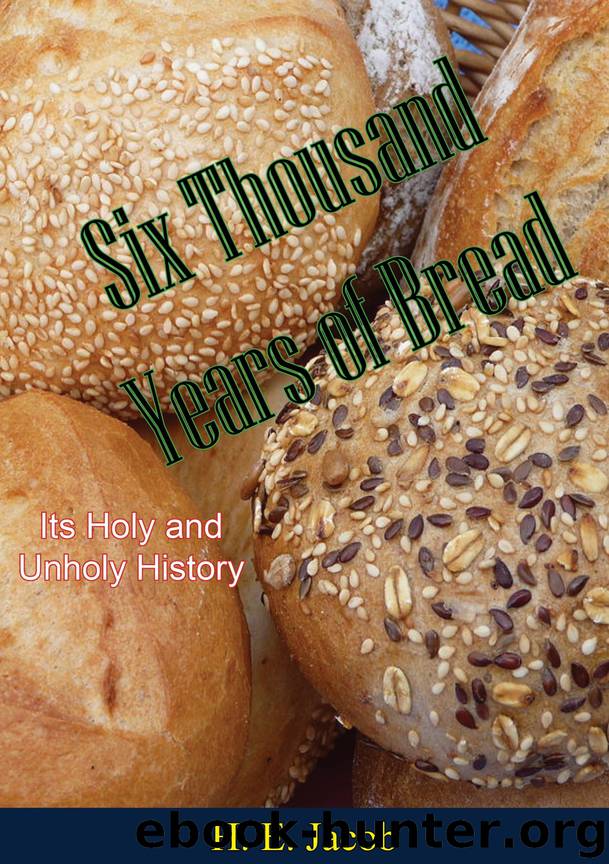Six Thousand Years of Bread by H. E. Jacob

Author:H. E. Jacob [Jacob, H. E.]
Language: eng
Format: epub, mobi
Publisher: Pickle Partners Publishing
Published: 2016-10-20T16:00:00+00:00
Porridge out of rotting maize,
Water from the puddle;
Master, work yourself,
For I am no longer able.
Although rotting maize was principally a problem of poor storage facilities, it began to seem that maize was a dangerous thing to grow in Italy. Then began a general flight from its “poisonous effect.” In the South of France, too, it was considered not edible for humans. This development went all the more swiftly, since wheat stood ready to take up the position that was abandoned by maize. In the course of years maize fell so utterly by the wayside that Jules Jusserand, once French Ambassador to Washington, declared in reply to an inquiry from American physicians:
Although the production of maize is on an average of about six million quintals a year I can tell you with positivity that an extremely small proportion of that amount is used for human food, almost the whole of it being employed for cattle.
The staff of life of the ancient American civilizations, the food that never failed to appear on the tables of Franklin, Washington, and Lincoln—was this splendid food to become only a feed for cattle? What a tragic decline!
The long injustice that had been done to maize was exposed by Casimir Funk (born 1870 in Warsaw), the famous discoverer of vitamins. The disappearance of the beriberi disease from the Japanese Navy since 1882, when Takaki introduced among the sailors a mixed diet of fruit and vegetables in place of the almost exclusive diet of rice, gave Funk the hint that pellagra, too, might be only a deficiency disease.
At the close of the nineteenth century two Dutch scientists in the East Indies had discovered that the beriberi disease spread to all places where modem machine mills replaced the primitive hand mills of the natives. The seed of the rice grain consists of two layers, an outer and an inner layer. The mills of the natives only incompletely removed the outer layer of the kernel; the modem machine mill removed it completely. The result was a highly polished rice—but a rice that lacked an important nutritional element and the natives showed inexplicable symptoms of disease. At last it was realized that the real nutritive value of the rice was contained precisely in the part that was thrown away. Funk proposed the name vitamine for these nitrogenous, crystalline bodies. The United States hailed the discovery and prohibited the polishing of rice in the Philippines. Within a few years the epidemic of beriberi ceased.
Pellagra, too, will cease, for pellagra is a deficiency disease, whose source is not the natural kernel of maize, but the modern mill, which cuts away the precious part of the kernel and makes flour out of the less nourishing part. If we examine a kernel of maize, we find the endosperm and the germ contained within a hard shell. While the kernel as a whole contains only 4.3 per cent fat, the germ alone is 29.6 per cent fat. That is, the germ is the most nutritive part. When it is sifted away, the result is the death of the vitamins.
Download
This site does not store any files on its server. We only index and link to content provided by other sites. Please contact the content providers to delete copyright contents if any and email us, we'll remove relevant links or contents immediately.
A Court of Wings and Ruin by Sarah J. Maas(7243)
The Sprouting Book by Ann Wigmore(3406)
Better Homes and Gardens New Cookbook by Better Homes & Gardens(3368)
The Death of the Heart by Elizabeth Bowen(3333)
BraveTart by Stella Parks(3304)
Salt, Fat, Acid, Heat: Mastering the Elements of Good Cooking by Nosrat Samin(2994)
Sauces by James Peterson(2956)
The Bread Bible by Rose Levy Beranbaum(2885)
Classic by Mary Berry(2831)
Kitchen confidential by Anthony Bourdain(2822)
Solo Food by Janneke Vreugdenhil(2817)
Ottolenghi - The Cookbook by Yotam Ottolenghi(2730)
Martha Stewart's Baking Handbook by Martha Stewart(2668)
Betty Crocker's Good and Easy Cook Book by Betty Crocker(2595)
Day by Elie Wiesel(2589)
My Pantry by Alice Waters(2430)
The Plant Paradox by Dr. Steven R. Gundry M.D(2423)
The Kitchen Counter Cooking School by Kathleen Flinn(2393)
Hot Sauce Nation by Denver Nicks(2367)
